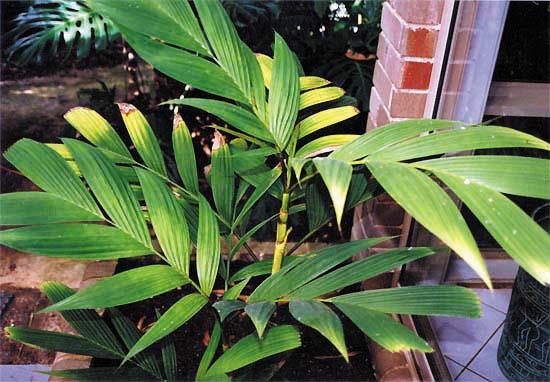Pinanga baviensis
| Pinanga (pih-NAHN-gah) baviensis (bah-vee-EN-sis) | |||||||
|---|---|---|---|---|---|---|---|
 North Vietnam. Photo by Christophe Sette. | |||||||
| Scientific Classification | |||||||
| |||||||
| Synonyms | |||||||
|
| |||||||
| Native Continent | |||||||
|
| |||||||
| Morphology | |||||||
| |||||||
| Culture | |||||||
|
| |||||||
| Survivability index | |||||||
|
| |||||||
| Common names | |||||||
|
| |||||||
Contents
Habitat and Distribution
China South-Central, China Southeast, Hainan, and Vietnam. Lowland rain forests. Fujian, Guangdong, Guangxi, Hainan, Yunnan (Vietnam).Description
Stems clustered or solitary, to 5 m tall, and 2.5 m in diameter, caesepitose (growing in tufts or clumps). Leaves pinnate; cownshafts present, green with reddish scales; petioles to 33 cm long; rachis to 1 m long with 3-12 broad to narrow, curved leaflets per side, rarely leaves undivided. Inflorescences pendulous, with 2-5 (rarely 1) smooth flowering branches, 10-15 cm long; flowers and fruits arranged in 2 opposite rows along the flowering branches; fruit ellipsoid, to 205 cm long and 1 cm in diameter, red. (Dr. Andrew J. Henderson 2009) Editing by edric.
Stems clustered, to 5 m tall, 0.8-2.5 cm in diam., reddish brown. Leaves pinnate, rarely undivided; sheaths closed and forming crownshafts, 18-34 cm, green or yellowish green, with brown scales; petioles 7-33 cm; rachis 32-100 cm; pinnae (1-)3-12 per side of rachis, gray-green abaxially, falcate, not contracted at bases, multi-veined, regularly arranged, closely spaced; middle pinnae 30-39 × 3-7 cm. Inflorescences branched, pendulous; peduncles 2-3 cm, ca. 0.4 cm wide; rachis 0-0.5 cm; rachillae (1 or)2-5, 10-15 cm, zigzag, rectangular in cross section, glabrous; triads distichously arranged, superficial on rachillae; male flowers to 13 mm, deciduous; sepals to 3.5 mm, connate into a 3-lobed, flat, membranous calyx; petals to 12 mm, unequal, triangular, fleshy, acute; stamens 20 or 21; female flowers to 3 mm; sepals to 3 mm, imbricate, rounded at apices or briefly acuminate, smooth or ciliate; petals to 3 mm, smooth or ciliate. Fruits red, ellipsoid, to 2.5 × 0.8-1 cm. (efloras.org) Editing by edric.
Culture
Warm, sheltered, and moist. Cold Hardiness Zone: 10b
Comments and Curiosities
- IMAGE GALLERY
External Links
References
Phonetic spelling of Latin names by edric.
Special thanks to Geoff Stein, (Palmbob) for his hundreds of photos.
Special thanks to Palmweb.org, Dr. John Dransfield, Dr. Bill Baker & team, for their volumes of information and photos.
Glossary of Palm Terms; Based on the glossary in Dransfield, J., N.W. Uhl, C.B. Asmussen-Lange, W.J. Baker, M.M. Harley & C.E. Lewis. 2008. Genera Palmarum - Evolution and Classification of the Palms. Royal Botanic Gardens, Kew. All images copyright of the artists and photographers (see images for credits).
Dr. Andrew J. Henderson, Palms of Southern Asia, page 148.
Many Special Thanks to Ed Vaile for his long hours of tireless editing and numerous contributions.































